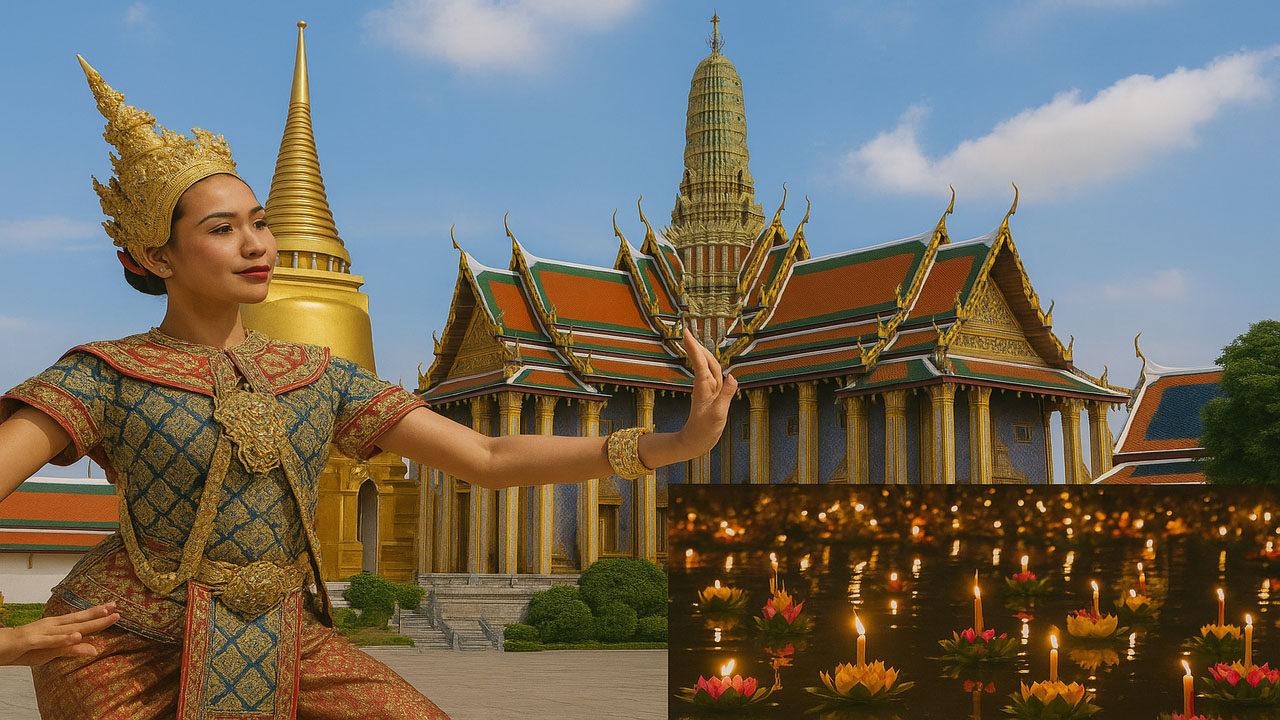
Thai Cultural Traditions: Dance Art, Tamples and Annual Festivals Event in Thailand
Mclub World – Discovering Thai Cultural Traditions: Dance Art, Temples, and Festivals
Thailand represents a vibrant nation with deeply rooted cultural values and ancient traditions.
Thai cultural traditions captivate both locals and international visitors through art, spirituality, and colorful celebrations. Visitors exploring Thailand can immerse themselves in its cultural richness through dance performances, temple visits, and lively festivals. This article, presented by Mclub World, explores these unique cultural attractions across Thailand.
Thai traditional dance art showcases graceful movements and elegant costumes symbolizing cultural stories and values. This art form often depicts legendary tales and folklore that reflect Thailand’s rich historical heritage. Dancers perform with deliberate hand gestures, facial expressions, and slow, precise body movements. These dances can be experienced during temple festivals, cultural shows, and royal ceremonies.
Khon, one of Thailand’s oldest dance styles, portrays scenes from the Ramakien epic. Performers wear intricately designed masks and elaborate costumes symbolizing gods, demons, and heroes. Khon performances offer unforgettable visual and storytelling experiences for both art enthusiasts and curious travelers.
“Read more : An Entertaining Annual Festival Event for Tourists who want to have Fun in Thailand“
Another popular form is Lakhon, where female dancers tell tales through coordinated group performances. Unlike Khon, Lakhon performers do not use masks but instead rely on expressive gestures and synchronized choreography. Lakhon is a must-see performance for travelers wanting to appreciate Thailand’s performing arts heritage.
In addition, Fawn Thai is a graceful northern dance using hand movements and traditional music. Audiences will notice the dancers’ delicate, fluid gestures accompanied by melodic instruments like the khim and ranat. These performances, often held at cultural events and festivals, provide a glimpse into Thailand’s regional diversity.
According to Mclub World, Thai dance art is not just entertainment; it is a reflection of deep spiritual beliefs.
Thailand is home to thousands of temples, known locally as ‘Wats,’ representing the nation’s Buddhist faith. These temples serve as spiritual centers where locals practice daily prayers, offerings, and meditation. For visitors, these sites offer tranquility, architectural beauty, and insights into Thai religious practices.
One of the most iconic is Wat Phra Kaew, located within Bangkok’s Grand Palace complex. It houses the Emerald Buddha, Thailand’s most revered statue, carved from a single jade block. Visitors can witness the changing of the statue’s garments, reflecting seasonal transitions and royal patronage.
Another breathtaking temple is Wat Arun, also known as the Temple of Dawn. Its riverside location and towering spires create stunning sunrise and sunset backdrops for photography enthusiasts. The temple’s exterior is adorned with colorful porcelain mosaics, creating a vibrant and spiritual ambiance.
In northern Thailand, visitors can explore Wat Phra That Doi Suthep in Chiang Mai. Situated atop a mountain, the temple offers panoramic city views and spiritual significance for local Buddhists. Legend says a white elephant carried a relic of Buddha and chose the temple’s site by circling the mountain.
Mclubworld.org recommends visitors dress modestly and respect temple customs during visits.
These temples not only provide historical learning but also a moment of peace amidst bustling city life.
“Read more : Synology® Officially Launches DiskStation DS925+ and DX525 Expansion Units“
Thailand’s annual festivals highlight the nation’s joy, unity, and reverence for tradition. These festivals combine spiritual rituals, cultural performances, and communal celebrations drawing participants nationwide.
Songkran, Thailand’s New Year festival, is celebrated every April with water fights and blessings. Locals and tourists alike join in, splashing water as a symbolic gesture of purification and renewal. Songkran also involves visiting temples, offering food to monks, and family reunions.
Loy Krathong, celebrated in November, is another captivating festival where people float decorated baskets on rivers. These krathongs carry candles, incense, and prayers, representing forgiveness and letting go of negativity. The illuminated rivers create a magical atmosphere, reflecting participants’ hopes for a brighter future.
In the northern region, Yi Peng festival lights up the skies with thousands of floating lanterns. This stunning event symbolizes letting go of misfortune and making new wishes for happiness and prosperity.
Travelers can experience these festivals best in Chiang Mai, where the events combine both Yi Peng and Loy Krathong.
Thailand also hosts the Phi Ta Khon festival, known as the ghost festival, celebrated in Loei province.
Locals dress in colorful masks and costumes, reenacting mythical tales while inviting spirits to join the festivities. The event showcases traditional dances, parades, and music, highlighting the region’s spiritual folklore.
According to Mclub World, these festivals reflect Thai people’s passion for community, spirituality, and celebration.
Thai cultural traditions offer more than just entertainment; they serve as bridges connecting history, art, and spirituality. Visitors can gain deeper cultural understanding by participating in these traditional events and respecting local customs. From the elegant dance performances to the grandeur of ancient temples and the excitement of vibrant festivals, Thailand presents a journey into its soul and heritage for all who seek authentic cultural experiences.
For those planning to immerse in these unforgettable experiences, mclubworld.org suggests timing visits around major festivals. Doing so ensures visitors witness Thailand at its most colorful and festive moments, embracing the heart of Thai cultural traditions.
This website uses cookies.